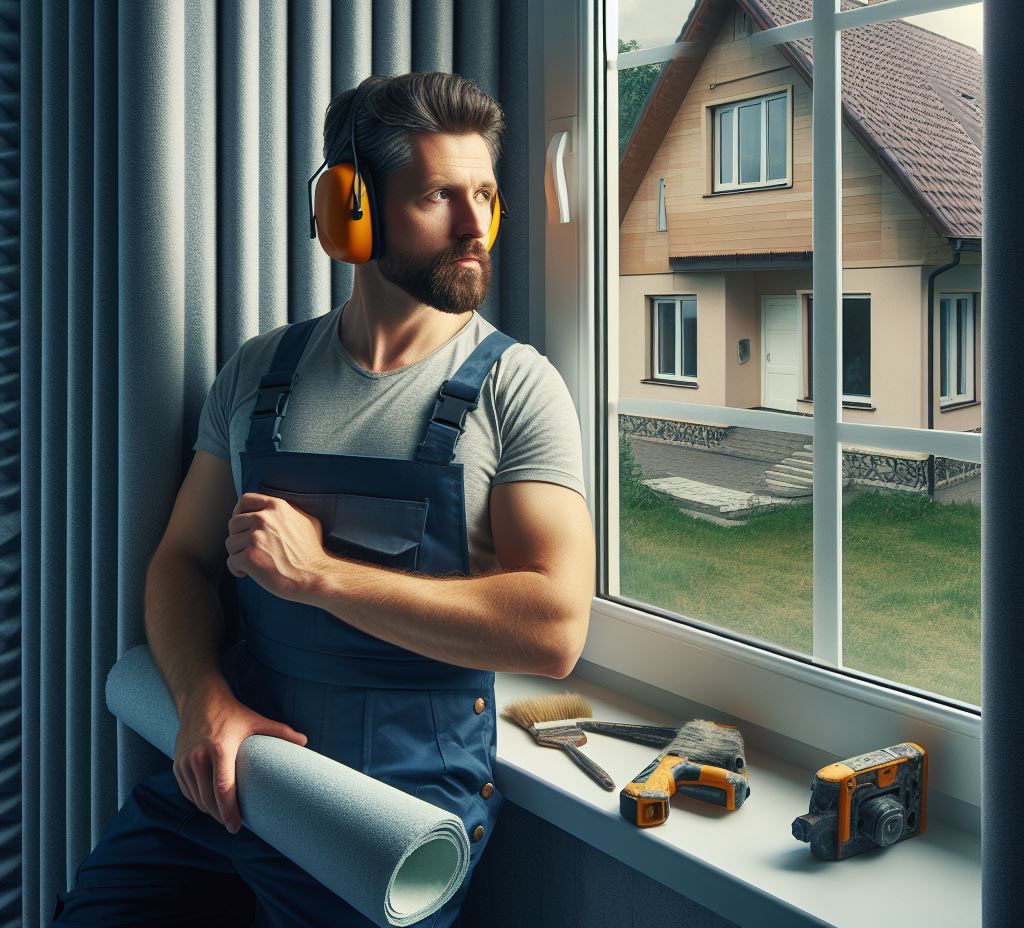Soundproofing your windows isn’t just about blocking out the neighbor’s dog or the early morning traffic. It’s a game-changer for your home’s tranquility and privacy. Dive into the nuts and bolts of soundproofing, and let’s transform your living space into a serene retreat.

Why Soundproof Your Windows?
- Noise Reduction. The hustle and bustle outside shouldn’t dictate the peace within your walls. Soundproofing your windows cuts down on everything from the roar of traffic to the buzz of a lawnmower, letting you enjoy your space in peace.
- Privacy and Comfort. Ever feel like your conversations are for public consumption? Soundproofing adds a layer of privacy, muffling sounds from both directions. Plus, it’s about creating a comfortable home environment, where you can unwind without interruption.
Understanding Soundproofing Principles
- Sound Transmission and Reduction. Sound travels in waves, finding its way through the smallest of gaps. Effective soundproofing disrupts these waves, using barriers that absorb, dampen, or reflect sound back. Understanding this principle is key to choosing the right soundproofing method.
- Types of Noise. There’s airborne noise, like talking and music, and then there’s impact noise, think of footsteps or a slamming door. Different soundproofing strategies tackle different types of noise, so identifying your main irritant is step one.
Materials and Tools Needed
For a solid DIY soundproofing project, you’ll need:
- Materials. Acoustic seals, dense foam panels, soundproofing curtains, and window inserts. Each plays a role in barricading against noise.
- Tools. Tape measure, utility knife, caulking gun, and adhesive. These are your bread and butter for a snug fit and seamless installation.
Remember, quality materials are half the battle. Skimping here could mean less-than-stellar results.
Step-by-Step Guide to Soundproofing Your Windows
- Assess the Situation. Examine your windows. Are there gaps or cracks? These are prime spots for sound leaks. Identifying them early sets you up for success.
- Seal the Gaps. Use acoustic caulk to fill any cracks around the window frame. It’s a simple step, but you’d be surprised at the difference it makes.
- Add Density. Sound loves to travel through thin barriers. Adding density with foam panels or window inserts can block that path. Measure your window, cut the material to fit, and secure it in place.
- Hang Soundproofing Curtains. These aren’t your average curtains. Made from dense materials, they absorb sound waves, adding another layer of sound defense.
- Install Window Inserts. If you’re up for a bit more of a project, window inserts are like adding a second window, creating a buffer zone that catches sound.

Tips for Maximizing Effectiveness:
- Double Check Your Work. Gaps and leaks are the enemy. After installing, go back and ensure everything is sealed tight.
- Layer Up. Using multiple soundproofing methods together will give you the best results. Think of it as layering up in winter — the more layers, the warmer you are.
- Maintenance. Over time, materials can degrade. Keeping an eye on the condition of your soundproofing and addressing any wear and tear is key to long-term success.
Types of Soundproofing Solutions
Diving into soundproofing, you’ve got a toolbox of techniques to choose from, each with its own set of pros and cons.
- Window Inserts. Like slipping a cozy sweater over your window, these inserts are a snug barrier against noise. They’re effective and relatively easy to install, but the upfront cost might make you think twice.
- Acoustic Caulk. This isn’t your average sealant. It fills cracks and gaps with the tenacity of a beaver building a dam. Affordable and efficient, the only downside is it requires a keen eye and a steady hand to apply correctly.
- Window Films. Think of these as sunglasses for your windows—not only do they reduce glare, but they can also dampen incoming noise. They’re sleek and hardly noticeable, though their soundproofing powers are more subtle than Superman’s.
Maintaining Soundproofing Efficiency
Keeping your soundproofing in tip-top shape is crucial for lasting peace and quiet. Here are a few pointers:
- Regular Checks. Every few months, do a walk-around. Look for any gaps, tears, or signs of wear in your soundproofing materials. An ounce of prevention is worth a pound of cure.
- Seal Refresh. Acoustic caulk isn’t forever. Check it annually, and don’t hesitate to reapply if you spot any cracks or shrinkage.
- Clean Inserts and Films. Dust and dirt can degrade materials over time. A gentle clean with a soft cloth can keep them effective—and your views clear.
Cost-Effective Soundproofing Tips
You don’t need a gold-plated solution to get golden silence. Here are budget-friendly ways to hush the hubbub:
- DIY Draft Stoppers. Those gaps under your doors are like open invitations for noise. A homemade draft stopper can be a quick fix.
- Thick Curtains. Heavy, dense curtains can muffle sound waves, especially if you’re on a shoestring budget.
- Rugs and Carpets. They’re not just for floors. Hanging a thick rug on a wall adjoining a noisy area can dampen sound surprisingly well.
FAQ Section
Absolutely. Seals, acoustic curtains, and window inserts can make a world of difference without the need for a full window overhaul.
Done right, it can turn down the volume significantly. Effectiveness varies with the method and noise type, but the difference is usually night and day.
Soundproofing curtains and window seals win here. They’re easy on the wallet and on the DIY skill set.
Many soundproofing tasks are within reach of the average DIYer. However, if you’re looking at a complex setup or want guaranteed results, bringing in a pro can be worth the cost.
